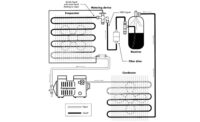The compressor lubricant in refrigeration and air conditioning systems has many important functions. Even though the refrigerant is the working fluid required for cooling, the lubricant or oil is needed for lubrication of the compressor’s moving mechanical parts.
Oil minimizes mechanical wear by reducing friction. Oil also maintains a seal between the high and low side of the compressor. Without proper lubrication, the compressor’s valves, mating scrolls, screws, and vanes would not properly seal. The results would be high-side refrigerant pressures entering the low side of the refrigeration system.
Piston rings in reciprocating compressors and rotating vanes in centrifugal compressors rely on the lubricating oil to prevent blow-by around the pistons and vanes. Oil also acts as a noise dampener within the compressor and transfers heat away from moving and rotating parts within the compressor.
Under normal conditions, there will always be a small amount of oil that escapes a compressor’s crankcase and is circulated with the refrigerant throughout the system. It is for this reason that refrigerant oil and the refrigerant itself must be soluble in one another. It is the velocity of the circulated refrigerant that carries the oil back to the compressor’s crankcase. If the two were not soluble in one another, this phenomenon could not happen. This is why line, coil, and valve sizing is critical to maintaining the refrigerant velocity required for proper oil return.
REFRIGERANT MIGRATION
During a compressor’s off cycle, and especially during a long shutdown, refrigerant will travel to a place where pressure is the lowest. Refrigerant migration is defined as refrigerant, either liquid or vapor, traveling to the compressor’s suction line or crankcase during the off cycle.
In nature, fluids travel from a place of higher pressure to a place of lower pressure. The crankcase usually has a lower pressure than the evaporator because of the oil it contains. Refrigeration oil has a very low vapor pressure and refrigerant will flow to it whether the refrigerant is in the vapor or liquid state. In fact, refrigerant oil has such a low vapor pressure it will not vaporize even when a 100-micron vacuum is pulled on the refrigeration system. Some refrigeration oils have a vapor pressure as low as 5-10 microns. If the oil did not have a very low vapor pressure, it would vaporize every time a low pressure existed in the crankcase or when a vacuum was pulled on the crankcase.
Because refrigeration migration can occur with refrigerant vapor, the migration can occur uphill or downhill. When the refrigerant vapor reaches the crankcase, it will be absorbed and condense in the oil. Once this phenomenon happens, the liquid refrigerant will be on the bottom of the oil in the crankcase because it is heavier than the oil. Often, manufacturers will incorporate a crankcase heater on the compressor.
Crankcase heaters are designed to help keep the oil in the compressor’s crankcase at a temperature higher than the coldest part of the refrigeration system. If refrigerant migration occurs as a vapor and the system has a crankcase heater, the vapor will be forced away from the crankcase and be driven back into the suction line. This refrigerant may condense in the suction line and cause slugging in the compressor’s cylinders on the next start-up. Crankcase heaters do combat refrigerant migration to the compressor’s crankcase oil. They also prevent oil and refrigerant dilution within the compressor’s crankcase. However, they do not prevent refrigerant slugging at start-up.
SLUGGING
With reciprocating compressors, slugging is liquid refrigerant or liquid oil actually trying to be compressed in the cylinders of the compressor. Slugging happens during the compressor’s on cycle. As we know, liquids cannot be compressed and attempts to do so generate tremendous reversal forces that often result in broken parts. Slugging can especially happen if the compressor is located outdoors in a cold ambient. The cold ambient will amplify the lower vapor pressure area and help condensed the refrigerant vapor to liquid. As mentioned earlier, a crankcase heater helps keep the oil in the crankcase free of refrigerant caused from refrigerant migration.
On short compressor off cycles, the migrated refrigerant does not have a chance to settle under the oil but still mixes with the oil in the crankcase. When the compressor turns on, the sudden pressure drop in the crankcase containing liquid refrigerant and oil will cause the refrigerant in the oil to rapidly flash to a vapor. This causes violent foaming in the crankcase. The oil level in the crankcase will then drop and mechanical parts will be scored from inadequate lubrication. The crankcase pressure will rise, and the mixture of refrigerant and oil foam can now be forced through compressor passages, around piston rings, and pumped by the compressor into the refrigeration system.
Not only does this situation cause loss of oil from the crankcase, it also can cause a mild form of slugging in the compressor’s cylinders. High compressor current draw, which will lead to motor overheating, usually follows. Also, broken or warped valves can occur as a result of overheating and/or slugging.
AUTOMATIC PUMP DOWN
The only sure remedy or solution to avoiding refrigerant migration is to get rid of all refrigerant in the evaporator, suction line, and crankcase before every off cycle. This can be accomplished via an automatic pump down system. A thermostat controlling box temperature is wired in series with a liquid line solenoid. When the box temperature is satisfied, the thermostat contacts open. This de-energizes the liquid line solenoid and initiates a pump down cycle. All the liquid and vapor refrigerant from the solenoid forward through the compressor will soon be pumped into the high side (condenser and receiver) of the system. Once the low-side pressure reaches about 10 psig, a low-pressure controller will interrupt the compressor circuit and initiate an off cycle. The system is now pumped down, and migration cannot occur because of lack of refrigerant vapor and liquid in the evaporator, suction line, and crankcase. Figure 1 illustrates an electrical and mechanical hookup of an automatic pump down system.
When the box thermostat calls for cooling, the liquid line solenoid is energized, and refrigerant pressure will travel through the metering device to the low side of the system. This pressure will cause the cut-in pressure of the low-pressure control to close its contacts and bring the compressor to another on cycle. The cut-in pressure for the low-pressure control is system- and refrigerant-dependent. It has to be high enough to prevent any short-cycling of the compressor during an off cycle but low enough to allow the low-side pressure to reach it when an on cycle is initiated by the box thermostat. Actual trial and error will allow a service technician to determine the low pressure control’s settings.
Most every low-pressure controller (LPC) has an adjustment to set the cut-in and cut-out pressure to cycle the compressor. There may also be a differential control on this same controller. The difference between the cut-in and cut-out pressures of the LPC is referred to as the differential. For example, if a system is set to cut-in at 25 psig and has a 15 psig differential, the cut-out pressure would be 10 psig. Refer to the equation below.
25 psig cut-in pressure
- 15 psig differential
= 10 psig cut-out pressure
It’s important not to let the low-side pressure get too low before shutting off the compressor. If the low-side pressure was allowed to drop to 0 psig before the low-pressure control terminated the cycle every off cycle, damage could occur to the compressor from lack of refrigerant mass-flow rate and high compression ratios. This severely unloads the compressor and may cause overheating from loss of the cooling effect on the compressor’s windings. A cut-out pressure of 10 psig is low enough to ensure most of the liquid and vapor refrigerant has been cleared from the evaporator, suction line, and crankcase to prevent refrigerant migration during the off cycle.
Many times, systems will use an electronic expansion valve (EEV) in place of the liquid line solenoid. An algorithm in the valve’s software will throttle the EEV closed when it is time for an automatic pump down to occur and open it when it is time for the next on cycle.
Publication date: 10/2/2017











